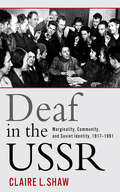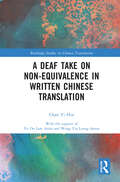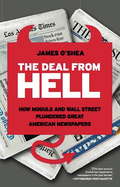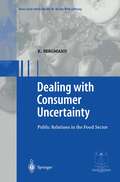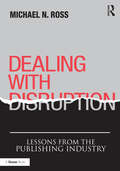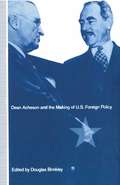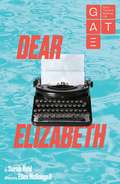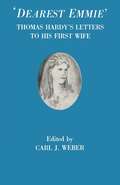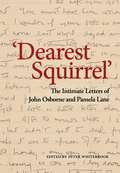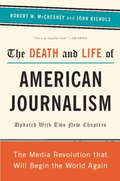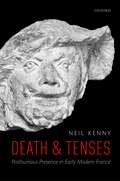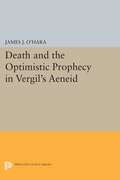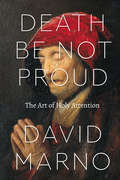- Table View
- List View
Deaf in the USSR: Marginality, Community, and Soviet Identity, 1917-1991
by Claire L. ShawIn Deaf in the USSR, Claire L. Shaw asks what it meant to be deaf in a culture that was founded on a radically utopian, socialist view of human perfectibility. Shaw reveals how fundamental contradictions inherent in the Soviet revolutionary project were negotiated—both individually and collectively— by a vibrant and independent community of deaf people who engaged in complex ways with Soviet ideology.Deaf in the USSR engages with a wide range of sources from both deaf and hearing perspectives—archival sources, films and literature, personal memoirs, and journalism—to build a multilayered history of deafness. This book will appeal to scholars of Soviet history and disability studies as well as those in the international deaf community who are interested in their collective heritage. Deaf in the USSR will also enjoy a broad readership among those who are interested in deafness and disability as a key to more inclusive understandings of being human and of language, society, politics, and power.
Deaf Rhetoric: An Ecology of Health Communication (SpringerBriefs in Public Health)
by Manako YabeThis book guides healthcare professionals, hospital administrators, and medical interpreters in the United States (and internationally) in ways to better communicate with Deaf and Hard of Hearing (D/HH) patients and sign language interpreters in healthcare settings. It also provides an overview of the healthcare communication issues with healthcare professionals and D/HH patients, and the advantages and disadvantages of using in-person interpreters vs. video remote interpreting (VRI). Due to technology development, hospital administrators have popularized the use of VRI and reduced the number of in-person interpreting services, which have negatively affected the quality of medical interpreting services and patient-provider communication. The COVID-19 pandemic also has accelerated the move toward more VRI, particularly in the US.The book addresses an understudied aspect of access and is written by an international deaf researcher from Japan who uses American Sign Language (ASL) and English as non-native languages. In order to identify appropriate interpreting services for specific treatments, the author focuses on healthcare professionals' and D/HH patients' interpreting preferences for critical and non-critical care in the US, and offers a new theoretical framework, an Ecology of Health Communication, to contextualize and analyze these preferences. The ecological matrix and its five analytical dimensions (i.e., physical-material, psychological, social, spatial, and temporal) allow readers to understand how these dimensions influence healthcare professionals' and D/HH patients' interpreting preferences as well as the treatment outcomes. This book concludes by prioritizing the use of an appropriate interpreter for specific treatments and allocating funds for in-person interpreters for critical care treatments.Deaf Rhetoric: An Ecology of Health Communication is primarily designed for healthcare professional students and professionals, hospital administrators, medical interpreters, VRI companies, and healthcare researchers. Scholars interested in the communication preferences of healthcare professionals and deaf people also will find this text useful. The book counters some of the power differences between healthcare providers and those who use medical services, and subtly reminds others that deaf people are not solely the receivers of medical care but actually are full people. The field of health care is growing and medical schools are increasingly called on to address cultural competencies; this resource provides a needed intervention.
A Deaf Take on Non-Equivalence in Written Chinese Translation (Routledge Studies in Chinese Translation)
by Chan Yi HinA Deaf Take on Non-Equivalence in Written Chinese Translation examines the issue of lexical non-equivalence between written Chinese and Hong Kong Sign Language (HKSL) translation, describing its theoretical and practical implications. This research foregrounds the semiotic resources in the Deaf community of Hong Kong by analyzing translation strategies exhibited by Deaf Hongkongers when they were invited to translate written Chinese passages with specialized and culturally specific concepts in a monologic setting. With discourse analysis as a framework, the major findings of this research were that: (1) a taxonomy of strategies featured depiction, manual representations of Chinese characters and visual metonymy, writing and mouthing; (2) employment of multisemiotic and multimodal resources gave intended viewers access to different facets of meaning; and (3) repeated renditions of the same concepts gave rise to condensed, abbreviated occasionalisms. Observations from this research serve as a point of reference for interpreting scholars, practitioners and students as well as policymakers who formulate interpretation service provision and assessment.
A Deaf Take on Non-Equivalence in Written Chinese Translation (Routledge Studies in Chinese Translation)
by Chan Yi HinA Deaf Take on Non-Equivalence in Written Chinese Translation examines the issue of lexical non-equivalence between written Chinese and Hong Kong Sign Language (HKSL) translation, describing its theoretical and practical implications. This research foregrounds the semiotic resources in the Deaf community of Hong Kong by analyzing translation strategies exhibited by Deaf Hongkongers when they were invited to translate written Chinese passages with specialized and culturally specific concepts in a monologic setting. With discourse analysis as a framework, the major findings of this research were that: (1) a taxonomy of strategies featured depiction, manual representations of Chinese characters and visual metonymy, writing and mouthing; (2) employment of multisemiotic and multimodal resources gave intended viewers access to different facets of meaning; and (3) repeated renditions of the same concepts gave rise to condensed, abbreviated occasionalisms. Observations from this research serve as a point of reference for interpreting scholars, practitioners and students as well as policymakers who formulate interpretation service provision and assessment.
The Deal from Hell: How Moguls and Wall Street Plundered Great American Newspapers
by James O'SheaIn 2000, after the Tribune Company acquired Times Mirror Corporation, it comprised the most powerful collection of newspapers in the world. How then did Tribune nosedive in to bankruptcy and public scandal? The Deal from Hell is the riveting narrative in which veteran editor James O'Shea takes us behind the scenes of the decisions that led to that ongoing disaster.
Dealing with consumer uncertainty: Public Relations in the Food Sector (Gesunde Ernährung Healthy Nutrition)
by Karin BergmannMy studies on the "uncertain consumer" began with a research project c- ducted by the Dr. Rainer Wild-Stiftung - Foundation for healthy nutrition - on the negative image of processed food. Ever since then I have been asked whether or not growing consumer uncertainty is linked to information po- cies of the food sector and if so, how. Intensive three-year research showed that industrial methods of food production are predestined to result in wayward fears and worry over its healthiness. This is due to the fact that during the process of industrialisation, we gradually passed responsibility for the quality of food into the producers' hands. This, in turn, has resulted in information gaps that we, as the addressees of diverse, often overwhelming and contrad- tory information supplied by varying sources, feel today. We exchanged the daily search for food for the daily search for information long ago. Con- quently, a practical concept for public relations stands at the end of my - search into the uncertain consumer. It accounts for uncertainty regarding processed food as a point of reference for public relations targeted towards various groups. Public relations oriented towards the future calls for the sharing of expert information with all interested consumers. It is the goal of businesses to actively build up trust among the consumers in order to be prepared for new causes for uncertainty appearing periodically. To this day the issue of consumer uncertainty has not lost its topicality.
Dealing with Disruption: Lessons from the Publishing Industry
by Michael N. RossPublishing today requires a presence in local and global markets, and successful publishers can be more effective in reaching both by employing current technology at all stages of the publishing process. Finding the most efficient and profitable business models has become more challenging (and more rewarding) by the same advancements in technology. Michael Ross provides a roadmap to the essential aspects of the international publishing industry, from how to develop content that can be easily adapted to other cultures, to establishing relationships and negotiating licensing and co-publishing contracts. With a discussion of the critical innovations in the industry and through case studies from all stages in the publishing process, the book provides insights into the maturing of digital publishing and the challenges and opportunities provided by new technologies. Many publishing models have emerged over the last 15 years, and technology has made the mechanics of publishing in general, and web publishing in particular, easier. Thus, the role of the professional publisher is being challenged, and issues of quality and trust are now competing with easy access to information. Publishing, in all forms, can be viewed as a conspicuous bellwether for any business that must make strategic and tactical adjustments quickly to innovate and grow. Ross applies principles from both consumer and educational publishing to explore publishing's ongoing 'sea change' and its implications for other industries.
Dealing with Disruption: Lessons from the Publishing Industry
by Michael N. RossPublishing today requires a presence in local and global markets, and successful publishers can be more effective in reaching both by employing current technology at all stages of the publishing process. Finding the most efficient and profitable business models has become more challenging (and more rewarding) by the same advancements in technology. Michael Ross provides a roadmap to the essential aspects of the international publishing industry, from how to develop content that can be easily adapted to other cultures, to establishing relationships and negotiating licensing and co-publishing contracts. With a discussion of the critical innovations in the industry and through case studies from all stages in the publishing process, the book provides insights into the maturing of digital publishing and the challenges and opportunities provided by new technologies. Many publishing models have emerged over the last 15 years, and technology has made the mechanics of publishing in general, and web publishing in particular, easier. Thus, the role of the professional publisher is being challenged, and issues of quality and trust are now competing with easy access to information. Publishing, in all forms, can be viewed as a conspicuous bellwether for any business that must make strategic and tactical adjustments quickly to innovate and grow. Ross applies principles from both consumer and educational publishing to explore publishing's ongoing 'sea change' and its implications for other industries.
Dean Acheson and the Making of U.S. Foreign Policy
by Douglas BrinkleyPresident Truman's Secretary of State (1949-53), Dean Acheson was a crucial figure in the shaping of the postwar world. In an astonishingly creative and demanding tenure Acheson was involved to a degree seldom realized today in a huge range of issues: from the creation of NATO to the Korean War. The result of a major commemorative conference, this volume brings together ten distinguished diplomatic historians, commissioned to write on various aspects of Acheson's career, based on primary archival research.
Dear Ally, How Do I Write a Book?
by Ally CarterProblem plot lines? Character chaos? Ask Ally! The definitive guide to writing from one of teen fiction's best-loved authors.Writing finally has its own agony aunt in bestselling author, Ally Carter. Always wanted to write? Not sure how to begin, or what to do with tricky characters or pesky plotlines? Ask Ally! Ally Carter is the internationally bestselling author of Gallagher Girls, Embassy Row and Heist Society. Known for her gripping plots and adventures that combine danger and glamour in equal measure, Ally knows how to write brilliant books for teen and YA readers.Now Ally and her author friends want to help YOU write the book you've always dreamed of. Part agony aunt, part writing guru, this writing guide is thoughtful, witty and best of all, useful.With advice from some of children's fiction's brightest stars including Holly Black, Cassandra Clare and Kody Keplinger.
Dear Elizabeth: A Play In Letters From Elizabeth Bishop To Robert Lowell And Back Again (Oberon Modern Plays)
by Sarah RuhlElizabeth Bishop and Robert Lowell were two of America’s most brilliant poets. Throughout their lifetime, they wrote over 400 letters to each other; spanning decades, continents, political eras. Their connection was messy and profound, platonic yet romantic, intense and intangible. A love that resists easy definition. These are their words. Susan Smith Blackburn award winner Sarah Ruhl has crafted a stunning and quietly bold piece of theatre about what it means to love someone, and all the questions we regret never asking.
Dear Fahrenheit 451: A Librarian’s Love Letters and Break-Up Notes to Her Books
by Annie SpenceHave you ever wished you could tell your favourite books just what they mean to you? Or wanted to give a piece of your mind to the ‘must-read’ book that you wish you hadn’t? Librarian Annie Spence has done just that, writing letters to the books under her care, from love letters to Matilda and The Goldfinch, to snarky break-up notes to Fifty Shades of Grey and The Hobbit. Annie’s letters will make you laugh, remind you why you love your favourite books, and give you lots of new entries for your reading list. She’s also on-hand to help out with your bookish dilemmas: recommendations for lazy readers; excuses to tell your friends when you’d rather stay home reading; and how to turn your lover into a reader. Hilarious, compassionate and smart, Dear Fahrenheit 451 is the consummate book-lover's book.
Dear Reader: The Comfort and Joy of Books
by Cathy Rentzenbrink'Dear Reader is a love letter to stories and reading from one of our very best memoirists . . . a book to cherish' - Nina Stibbe, author of Love, NinaFor as long as she can remember, Cathy Rentzenbrink has lost and found herself in stories. Growing up she was rarely seen without her nose in a book and read in secret long after lights out. When tragedy struck, books kept her afloat. Eventually they lit the way to a new path, first as a bookseller and then as a writer. No matter what the future holds, reading will always help.Dear Reader is a moving, funny and joyous exploration of how books can change the course of your life, packed with recommendations from one reader to another.From the Sunday Times bestselling author of The Last Act of Love.
'Dearest Squirrel…': The Intimate Letters of John Osborne and Pamela Lane
by John Osborne Peter Whitebrook Pamela LaneA completely fresh insight into the mind of one of the UK’s greatest playwrights, the letters between John Osborne and his first wife, actress Pamela Lane, are also a love letter to a now defunct system of repertory theatre, and life in post-war Britain.As these letters reveal, soon after their divorce, Osborne and Lane began a mutually supportive, loyal, frequently stormy and sometimes sexually intimate alliance lasting thirty years until Osborne’s death. By the mid-1980s, they had become closer and more trusting than they had been since their earliest years together. ‘You are for me what you always were,’ Pamela told him, ‘I am in love with you still.’ It is, he declared, ‘my fortune to have loved someone for a lifetime.’Acerbic, witty, candid and heartbreaking, they reveal a unique relationship, troubled, tender and enduring.
The Death and Afterlife of Achilles
by Jonathan S. BurgessAchilles’ death—by an arrow shot through the vulnerable heel of the otherwise invincible mythic hero—was as well known in antiquity as the rest of the history of the Trojan War. However, this important event was not described directly in either of the great Homeric epics, the Iliad or the Odyssey. Noted classics scholar Jonathan S. Burgess traces the story of Achilles as represented in other ancient sources in order to offer a deeper understanding of the death and afterlife of the celebrated Greek warrior. Through close readings of additional literary sources and analysis of ancient artwork, such as vase paintings, Burgess uncovers rich accounts of Achilles’ death as well as alternative versions of his afterlife. Taking a neoanalytical approach, Burgess is able to trace the influence of these parallel cultural sources on Homer’s composition of the Iliad. With his keen, original analysis of hitherto untapped literary, iconographical, and archaeological sources, Burgess adds greatly to our understanding of this archetypal mythic hero.
The Death and Life of American Journalism: The Media Revolution That Will Begin the World Again
by Robert W McChesney John NicholsAmerican journalism is collapsing as newspapers and magazines fail and scores of reporters are laid off across the country. Conventional wisdom says the Internet is to blame, but veteran journalists and media critics Robert W. McChesney and John Nichols disagree. The crisis of American journalism predates the Great Recession and digital media boom. What we are witnessing now is the end of the commercial news model and the opportune moment for the creation of a new system of independent journalism, one subsidized by the public and capable of safeguarding our democracy.
The Death and Life of American Journalism: The Media Revolution That Will Begin the World Again
by Robert W. McChesney John NicholsDaily newspapers are closing across America. Washington bureaus are shuttering; whole areas of the federal government are now operating with no press coverage. International bureaus are going, going, gone. Journalism, the counterbalance to corporate and political power, the lifeblood of American democracy, is not just threatened. It is in meltdown. In The Death and Life of American Journalism, Robert W. McChesney, an academic, and John Nichols, a journalist, who together founded the nation's leading media reform network, Free Press, investigate the crisis. They propose a bold strategy for saving journalism and saving democracy, one that looks back to how the Founding Fathers ensured free press protection with the First Amendment and provided subsidies to the burgeoning print press of the young nation.
Death and Tenses: Posthumous Presence in Early Modern France
by Neil KennyIn what tense should we refer to the dead? The question has long been asked, from Cicero to Julian Barnes. Answering it is partly a matter of grammar and stylistic convention. But the hesitation, annoyance, and even distress that can be caused by the "wrong" tense suggests that more may be at stake—our very relation to the dead. This book, the first to test that hypothesis, investigates how tenses were used in sixteenth and early seventeenth-century France (especially in French but also in Latin) to refer to dead friends, lovers, family members, enemies, colleagues, writers, officials, kings and queens of recent times, and also to those who had died long before, whether Christ, the saints, or the ancient Greeks and Romans who posthumously filled the minds of Renaissance humanists. Did tenses refer to the dead in ways that contributed to granting them differing degrees of presence (and absence)? Did tenses communicate dimensions of posthumous presence (and absence) that partly eluded more concept-based affirmations? The investigation ranges from funerary and devotional writing to Eucharistic theology, from poetry to humanist paratexts, from Rabelais's prose fiction to Montaigne's Essais. Primarily a work of literary and cultural history, it also draws on early modern grammatical thought and on modern linguistics (with its concept of aspect and its questioning of "tense"), while arguing that neither can fully explain the phenomena studied. The book briefly compares early modern usage with tendencies in modern French and English in the West, asking whether changes in belief about posthumous survival have been accompanied by changes in tense-use.
Death and the Early Modern Englishwoman
by Lucinda M. BeckerThis study explores the female experience of death in early modern England. By tracing attitudes towards gender through the occasion of death, it advances our understanding of the construction of femininity in the period. Becker illustrates how dying could be a positive event for a woman, and for her mourners, in terms of how it allowed her to be defined, enabled and elevated. The first part of the book gives a cultural and historical overview of death in early modern England, examining the means by which human mortality was confronted, and how the fear of death and dying could be used to uphold the mores of society. Becker explores particularly the female experience of death, and how women used the deathbed as a place of power from which to bestow dying maternal blessings, or leave instructions and advice for their survivors. The second part of the study looks at 'good' and 'bad' female deaths. The author discusses the motivation behind the reporting of the deaths and the veracity of such accounts, and highlights the ways in which they could be used for religious, political and patriarchal purposes. The third section of the book considers how death could, paradoxically, liberate a woman. In this section Becker evaluates the opportunity for female involvement in dying and posthumous rituals, including funeral rites and sermons, commemorative and autobiographical writing and literary legacies. While accounts of dying women largely underpinned the existing patriarchy, the experience of dying allowed some women to express themselves by allowing them to utilise an established male discourse. This opportunity for expression, along with the power of the deathbed, are the focus for this study.
Death and the Early Modern Englishwoman
by Lucinda M. BeckerThis study explores the female experience of death in early modern England. By tracing attitudes towards gender through the occasion of death, it advances our understanding of the construction of femininity in the period. Becker illustrates how dying could be a positive event for a woman, and for her mourners, in terms of how it allowed her to be defined, enabled and elevated. The first part of the book gives a cultural and historical overview of death in early modern England, examining the means by which human mortality was confronted, and how the fear of death and dying could be used to uphold the mores of society. Becker explores particularly the female experience of death, and how women used the deathbed as a place of power from which to bestow dying maternal blessings, or leave instructions and advice for their survivors. The second part of the study looks at 'good' and 'bad' female deaths. The author discusses the motivation behind the reporting of the deaths and the veracity of such accounts, and highlights the ways in which they could be used for religious, political and patriarchal purposes. The third section of the book considers how death could, paradoxically, liberate a woman. In this section Becker evaluates the opportunity for female involvement in dying and posthumous rituals, including funeral rites and sermons, commemorative and autobiographical writing and literary legacies. While accounts of dying women largely underpinned the existing patriarchy, the experience of dying allowed some women to express themselves by allowing them to utilise an established male discourse. This opportunity for expression, along with the power of the deathbed, are the focus for this study.
Death and the Labyrinth
by Michel Foucault James Faubion Charles RuasDeath and the Labyrinth is unique, being Foucault's only work on literature. For Foucault this was "by far the book I wrote most easily and with the greatest pleasure". Here, Foucault explores theory, criticism and psychology through the texts of Raymond Roussel, one of the fathers of experimental writing, whose work has been celebrated by the likes of Cocteau, Duchamp, Breton, Robbe Grillet, Gide and Giacometti.This revised edition includes an introduction, chronology and bibliography to Foucault's work by James Faubion, an interview with Foucault, conducted only nine months before his death, and concludes with an essay on Roussel by the poet John Ashbery.
Death and the Optimistic Prophecy in Vergil's AENEID (PDF)
by James J. O'HaraHere James O'Hara shows how the deceptive nature of prophecy in the Aeneid complicates assessment of the poem's attitude toward its hero's achievement and toward the future of Rome under Augustus Caesar. This close study of the language and rhetorical context of the prophecies reveals that they regularly suppress discouraging material: the gods send promising messages to Aeneas and others to spur them on in their struggles, but these struggles often lead to untimely deaths or other disasters only darkly hinted at by the prophecies. O'Hara finds in these prophecies a persistent subtext that both stresses the human cost of Aeneas' mission and casts doubt on Jupiter's promise to Venus of an "endless empire" for the Romans. O'Hara considers the major prophecies that look confidently toward Augustus' Rome from the standpoint of Vergil's readers, who, like the characters within the poem, must struggle with the possibility that the optimism of the prophecies of Rome is undercut by darker material partially suppressed. The study shows that Vergil links the deception of his characters to the deceptiveness of Roman oratory, politics, and religion, and to the artifice of poetry itself. In response to recent debates about whether the Aeneid is optimistic or pessimistic, O'Hara argues that Vergil expresses both the Romans' hope for the peace of a Golden Age under Augustus and their fear that this hope might be illusory.Originally published in 1990.The Princeton Legacy Library uses the latest print-on-demand technology to again make available previously out-of-print books from the distinguished backlist of Princeton University Press. These editions preserve the original texts of these important books while presenting them in durable paperback and hardcover editions. The goal of the Princeton Legacy Library is to vastly increase access to the rich scholarly heritage found in the thousands of books published by Princeton University Press since its founding in 1905.
Death Be Not Proud: The Art of Holy Attention (Class 200: New Studies in Religion)
by David MarnoThe seventeenth-century French philosopher Nicolas Malebranche thought that philosophy could learn a valuable lesson from prayer, which teaches us how to attend, wait, and be open for what might happen next. Death Be Not Proud explores the precedents of Malebranche’s advice by reading John Donne’s poetic prayers in the context of what David Marno calls the “art of holy attention.” If, in Malebranche’s view, attention is a hidden bond between religion and philosophy, devotional poetry is the area where this bond becomes visible. Marno shows that in works like “Death be not proud,” Donne’s most triumphant poem about the resurrection, the goal is to allow the poem’s speaker to experience a given doctrine as his own thought, as an idea occurring to him. But while the thought must feel like an unexpected event for the speaker, the poem itself is a careful preparation for it. And the key to this preparation is attention, the only state in which the speaker can perceive the doctrine as a cognitive gift. Along the way, Marno illuminates why attention is required in Christian devotion in the first place and uncovers a tradition of battling distraction that spans from ascetic thinkers and Church Fathers to Catholic spiritual exercises and Protestant prayer manuals.
Death Be Not Proud: The Art of Holy Attention (Class 200: New Studies in Religion)
by David MarnoThe seventeenth-century French philosopher Nicolas Malebranche thought that philosophy could learn a valuable lesson from prayer, which teaches us how to attend, wait, and be open for what might happen next. Death Be Not Proud explores the precedents of Malebranche’s advice by reading John Donne’s poetic prayers in the context of what David Marno calls the “art of holy attention.” If, in Malebranche’s view, attention is a hidden bond between religion and philosophy, devotional poetry is the area where this bond becomes visible. Marno shows that in works like “Death be not proud,” Donne’s most triumphant poem about the resurrection, the goal is to allow the poem’s speaker to experience a given doctrine as his own thought, as an idea occurring to him. But while the thought must feel like an unexpected event for the speaker, the poem itself is a careful preparation for it. And the key to this preparation is attention, the only state in which the speaker can perceive the doctrine as a cognitive gift. Along the way, Marno illuminates why attention is required in Christian devotion in the first place and uncovers a tradition of battling distraction that spans from ascetic thinkers and Church Fathers to Catholic spiritual exercises and Protestant prayer manuals.
